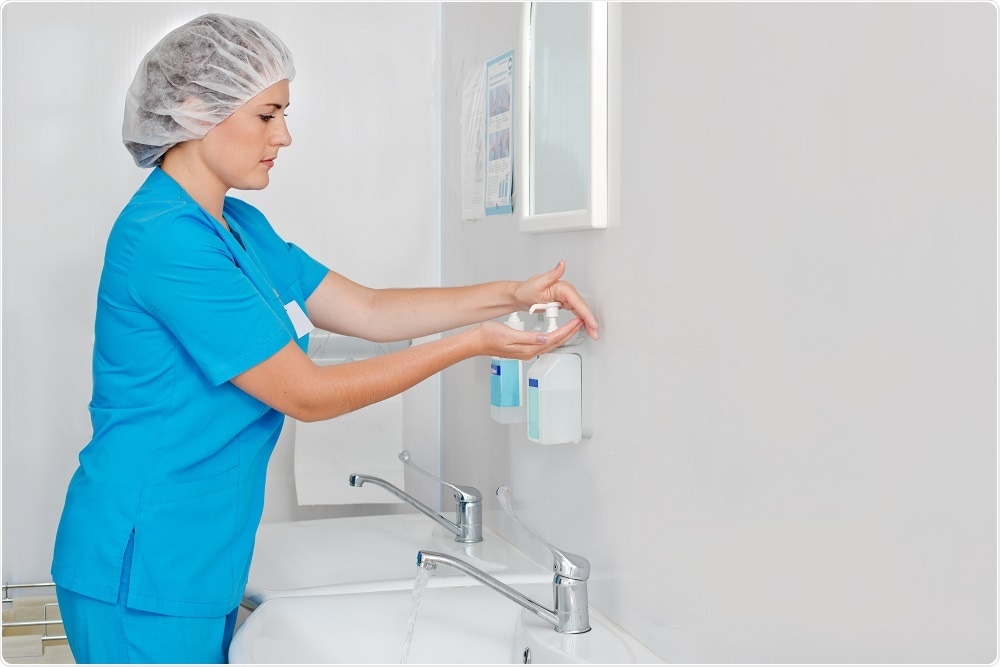The biggest disease-causing pathogens are cold and flu, which are spread through respiratory secretions when someone sneezes, and contaminated environments. The questions for contaminated environments are; how do we keep the surface clean? And, how do we prevent individuals from touching a surface and then their faces including their mouths?
Other infectious diseases that are commonly spread are GI related diseases caused by norovirus and rotavirus. This disease can spread rapidly through a cruise ship, on a plane, or even in a school with devastating consequences. Major sources of disease-causing pathogens are public restrooms and restaurants with poor hygiene. These are all vectors for disease transmission.
What are the current hand hygiene recommendations for healthcare professionals?
In the United States, the Center for Disease Control (CDC) sets very strict guidelines on hand hygiene that have been used for years. They recommend that healthcare professionals (HCPs) wash their hands before and after eating, using the restroom, and between patients.
In events where HCPs have no access to soap and water, they are instructed to use an alcohol-based hand sanitizer that is at least 60% ethanol. Ethanol-based sanitizers are the gold standard for hand hygiene, according to the CDC. Whilst it’s a very effective product, it is not without its faults as it leaves the hands clean but loses effectivity the second it dries.
Healthcare workers are doing the best that they can, but they're limited by technology, and what the FDA thought would be doing in a normal day, and how many times they would be cleaning their hands, differs drastically from reality. As a result, some of the original products contain such strong antimicrobials in them and are so often used by healthcare workers that they were being absorbed into the body.
The other issue that we've encountered is healthcare workers using hand sanitizer at such a level that they dry out their hands, making the skin barrier more susceptible to infection, since the surface is damaged, which in turn means healthcare workers do not follow standard protocols because their hands hurt.
Do you think that the current recommendations are outdated?
Hand hygiene is widely recognized as the single largest variable in the spread of infection, but recommended strategies for hand hygiene have remained largely unchanged for the past decade.
The recommended strategies are not only outdated, but are also limited by a lack of up-to-date technology. Part of my job is to introduce better products/better substances that are kinder on the skin, safer and allow the hands to stay cleaner for longer. The added advantage of this is that it makes people more likely to use them, more frequently.
It's estimated that 80% of diseases and illnesses in humans are transmitted by the hands. If there's a way to clean hands and maintain cleanliness so that the minute the hands meet a contaminated surface they don’t have to be washed again, that would be a major step forward.
Most of the products used in hospitals and medical centers contain Chlorohexidine. These products are very good at killing bacteria on the hands, but are also very damaging to the skin barrier. Products like this are also often expensive and have recently been linked to allergies. So, it’s imperative for healthcare workers to use a product that can clean hands and afford some residual protection, that also encourages compliance and routine use that protects others.
Are there any new technologies available that could address the issue of hand hygiene and reduce infection rates?
There's some novel antimicrobials on the market. One in particular is Zoono's GermFree24, a unique hand sanitizer that imparts a protective barrier onhands and has passed the many disinfection and sanitizing assays required of hand sanitizers in the US.
We can clean our hands with Zoono, grab a dirty doorknob 15 minutes later, and our hands will still be protected. We have demonstrated this through many studies in schools and hospitals and found that it reduces the pathogen load in the environment. We believe this kind of persistent hygiene has several benefits over just asking someone to wash their hands, or use hand sanitizer up to 15-20 times a day.
The mode of action for alcohol-based hand sanitizers is for the ethanol to dehydrate the microbe and kill it. Once the ethanol dries, our hands are completely susceptible to the next assault. With Zoono's GermFree24, the population is less likely to contract germs that can make them sick, which are commonly picked up and transferred by hands.

Credit: nata-lunata/Shutterstock.com
A major contributing factor to the recent rise in Healthcare Associated Infections (HAI) is hand hygiene. Are there any changes that could be made to improve HAI rates?
The level of hospital-acquired infections (HAI) has seen a gradual decrease, but people are still getting sick and often, HAIs are fatal.
A pressing issue in the United States is that the way that insurance companies reimburse hospitals depends on the level of HAIs in that particular hospital. This means that the hospital may not get paid, or could be penalized, if their level of HAIs are higher than what the CDC deems normal.
This may or may not be fair, but it means that HAIs are of high awareness for hospitals. This is of importance as the level of HAIs are now public records, so people can go online and compare hospitals levels of infections. There is; therefore, a great focus to implement innovative technology into hospitals that will minimize this, as patient safety is a number one priority.
Many hospitals across the US have introduced ultraviolet lights in rooms to sanitize them, but this is expensive, with each light costing $80,000. Therefore, less costly measures need to be considered.
Is there any correlation between high hand hygiene compliance and better patient outcomes?
There is a correlation between high hand hygiene compliance and patient outcomes.There are a lot of published studies on what hand hygiene compliance means. Some estimate that with a properly executed hand hygiene program we could decrease human illness that is pathogen-related by 50 percent.
The challenge though is that compliance is measuring how we use current products, which would be hand washing with soap, surgical scrubs for the surgical suite, and alcohol-based hand sanitizers in the hospital setting. So even in the best scenarios and by the best estimates, that would only decrease it by 50 percent.
Falters in hospital compliance can be linked to what level of importance a hospital puts on compliance. Is it routinely front and center so everyone knows why it's important? Is it monitored once a month? Following breakdowns do they re-educate people on how to do it? How trained are the personnel responsible for it? If there's high personnel turnover, then there's a learning curve, which can open some deficits in the process.
The key metric used by healthcare professionals to monitor hand hygiene is “compliance”. Do you think that compliance with the current hand hygiene protocols is still the most effective way to evaluate hand hygiene?
What we should be doing is assessing what we think are best practices, and what products we're using. Studies have shown examples of products being applied correctly by staff yet Staphylococcus Aureus could still be cultured on surfaces.
It is important to use products that offer sustained cleanliness or hygiene so that in the event of a minor breakdown in the process, a second protective layer prevents the surface from supporting bacterial growth. It's become so rampant now that in the US they've limited children coming into hospitals to visit patients during periods when infection rates are highest including during cold and flu season to reduce the risk and spread of germs and viruses. Even though the CDC has very strict guidelines on compliance, and very strict guidelines on products to use, they still know that the level of disease transmission and HAIs is too high.
What are the current barriers to compliance? Are the current barriers to compliance being addressed?
There’s a financial implication for healthcare reimbursement, and a social perception of the cleanliness of hospital Hospitals are doing everything they can within their current understanding of best practice, but it is still not enough. Every time I've been to the doctor or the hospital with my children, the doctors wash their hands before and after, and they apply hand sanitizer before they pick up anything. But even then, infection rates for that hospital are still high.
Compliance is more of a policy issue that an institution puts in place, and they take the best practices that the World Health Organization or the CDC is putting out. We should be asking what can we do to make sure that we provide long-lasting protection, and that we give offer some level of sustained hygiene. This product will likely not be an alcohol-based product or involve washing hands more often.
Clean Hands Count
Which is more important, changing behavior towards hand hygiene or changing our environment to reduce the spread of infection?
Since changing behaviors is the hardest of any equation, receiving wide acceptance of a better technology that keeps hands cleaner would be the best solution. It is necessary to use products on hands and surfaces that retard pathogen growth in between cleaning and provide some residual activity. Then, when compliance has breakdowns, the risk of disease transmission and the probability that we are going to get sick reduces drastically.
We all expected high-powered chemical cleaners and UV sanitized rooms to bring the level of pathogen load in a room practically down to zero, which we’re just not seeing, so there needs to be a next logical step.
First, we need to get surfaces as clean as possible, using a technology such as Zoono that imparts some residual activity to keep that surface and our hands cleaner. Being a microbiologist, having witnessed a huge push in the last decade for surfaces that contain silver, copper, or surfaces that prevent bacteria from re-growing on them, the industry knows better technologies are needed.
What do you think is the best way to ensure hands are consistently in an elevated state of hygiene?
Firstly, for the healthcare community and consumers need to learn about solutions that are gentle on the skin and afford protection against environmental pathogens. Products that include some strong chemical ingredients and cause sensitization need to be halted. We need acceptance of products such as Zoono’s hand and surface protectants that provide a protective barrier but also moisturize the hands, with ingredients that are non-toxic and safe to use for all including children.
Where can readers find more information?
About Dr. Andrew Alexander

Dr. Andrew Alexander is a Senior Scientific Officer for Zoono, USA. He is a trusted professional with over 25 years’ experience in the pharmaceutical, biotech, veterinary, and medical device development and the development, testing, and commercialization of life science products. Currently, Dr. Alexander is focused on developing novel antimicrobial products for the human and veterinary markets.
Dr. Alexander holds degrees in Veterinary Medicine and Surgery, a Ph.D. in Biomolecular Science, and completed a post-doctoral fellowship in Oncology and Immunology.
He also holds an MBA from the University of Wisconsin and is a Diplomate of the American Board of Toxicology (DABT), and a member of Beta Gamma Sigma, International Honor Society for Business Scholars.